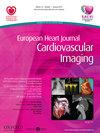Additional prognostic value of fully-automatic Global Longitudinal Strain using machine learning
引用次数: 0
Abstract
Abstract Funding Acknowledgements Type of funding sources: None. Background Several studies described the independent prognostic value of left ventricular global longitudinal strain (GLS) using cardiovascular magnetic resonance (CMR) to predict cardiovascular events. However, the potential interest of GLS using a fully automatic method assessed at rest during a stress CMR exam was not well established. Aim To assess the prognostic value of GLS to predict all-cause death using a fully automatic machine learning algorithm without human correction in consecutive patients referred for stress CMR. Methods Between 2016 and 2018, all consecutive patients referred for stress CMR were included and followed for the occurrence of all-cause death. A fully automatic machine learning algorithm was trained and validated unseen CMR studies (MAGNETOM Aera and Skyra, Siemens Healthcare, Erlangen, Germany) to assess the GLS from long-axis cine images acquired at rest. The algorithm combines multiple deep learning networks for detection and segmentation with an active contours approach. Cox regressions were performed to determine the prognostic value of GLS. Results Among 9,883 consecutive patients who underwent stress CMR between 2016 and 2018 retrospectively included, the automatic GLS was successfully computed in 9,638 (97.5%) patients (67% male, mean age 66±12 years). A total of 510 (5.3%) deaths were observed during a median (IQR) follow-up period of 4.5 (3.7–5.2) years. GLS, the presence of inducible ischemia and late gadolinium enhancement (LGE) were significantly associated with the occurrence of death (hazard ratio, HR: 1.22 [95% CI, 1.17–1.26]; HR: 2.23 [95% CI, 1.61–3.10]; and HR: 2.04 [95% CI, 1.41–2.95], respectively, all p<0.001). After adjustment for traditional risk factors, inducible ischemia and LGE, GLS was an independent predictor of a higher incidence of death (adjusted HR: 1.14 [95% CI, 1.08–1.20]). Automatic GLS showed an incremental prognostic value to predict death compared to traditional risk factors, inducible ischemia and LGE (C-statistic improvement: 0.05; NRI=0.146; IDI=0.244; all p<0.001). Conclusions Automatic GLS measured at rest has an incremental prognostic value to predict all-cause death above traditional risk factors, and other stress CMR parameters.使用机器学习的全自动全局纵向应变的附加预测价值
资金来源类型:无。一些研究描述了使用心血管磁共振(CMR)预测心血管事件的左心室整体纵向应变(GLS)的独立预后价值。然而,在压力性CMR检查中使用全自动方法在休息时评估GLS的潜在兴趣尚未得到很好的确立。目的评估GLS在连续转诊进行应激性CMR的患者中使用无需人为校正的全自动机器学习算法预测全因死亡的预后价值。方法纳入2016 - 2018年所有连续行应激性CMR的患者,随访全因死亡的发生情况。全自动机器学习算法被训练并验证了未见过的CMR研究(MAGNETOM Aera和Skyra, Siemens Healthcare, Erlangen, Germany),以评估静止时获得的长轴电影图像的GLS。该算法将用于检测和分割的多个深度学习网络与活动轮廓方法相结合。采用Cox回归分析确定GLS的预后价值。结果在2016 - 2018年连续9883例接受应激性CMR的患者中,9638例(97.5%)患者(67%男性,平均年龄66±12岁)成功自动计算GLS。在中位(IQR)随访时间为4.5(3.7-5.2)年期间,共观察到510例(5.3%)死亡。GLS、诱导性缺血和晚期钆增强(LGE)与死亡发生显著相关(风险比,HR: 1.22 [95% CI, 1.17-1.26];Hr: 2.23 [95% ci, 1.61-3.10];和HR分别为2.04 [95% CI, 1.41-2.95], p < 0.05;lt;0.001)。在对传统危险因素、诱导性缺血和LGE进行校正后,GLS是较高死亡发生率的独立预测因子(校正风险比:1.14 [95% CI, 1.08-1.20])。与传统危险因素、诱导性缺血和LGE相比,自动GLS预测死亡的预后价值有所增加(c -统计学改善:0.05;个新名词= 0.146;伊迪= 0.244;所有p&肝移植;0.001)。结论静止时自动测量GLS对预测全因死亡的预后价值高于传统危险因素和其他应激CMR参数。
本文章由计算机程序翻译,如有差异,请以英文原文为准。
求助全文
约1分钟内获得全文
求助全文

 求助内容:
求助内容: 应助结果提醒方式:
应助结果提醒方式:


